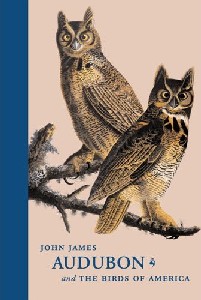Reviewed by Grant McCreary on January 26th, 2007.
I trust everyone reading this knows who John James Audubon is (if not, then this book is for you!). Even most non-birders at least know the name, and most everyone has seen one of his works, whether they recognized it or not. His best known work is the collection of his North American bird portraits – The Birds of America. That work is undoubtedly a masterpiece and deserves the attention that it commands. However, the life of the man responsible for it and the story of its development is every bit as interesting.
The first third of this book is a brief biography of Audubon. It explores the roots of his obsession with birds, how he ended up in America, his life here, and the genesis of his ambitious project. It concludes with the amazing story of the fruition of his dream to publish his work. This book is not intended to give a complete biography. It barely scratches the surface of his many expeditions and leaves many questions unanswered (including one of mine – how many species did Audubon actually discover?).
The remainder of the book consists of a selection of 24 plates. The reproduction of the artwork here looks fantastic. The print and paper quality is outstanding. You can certainly get a good appreciation of the work, but the images are relatively small even though they nearly fill the page. The facing page contains details on the original work such as when and where it was created. Vedder also gives a brief introduction to the work, but the majority of the text here is taken from the illustrated species’ account in Audubon’s Ornithological Biography.
The Ornithological Biography is a collection of species accounts Audubon published separately from the artwork. These are far less well known than the art, but equally impressive. Audubon claimed that “no man living knows better than I do the habits of our birds; no man living has studied them as much as I have done”, and he shares that knowledge in these accounts. Audubon was not a trained scientist and he did not write like one. The accounts are entertaining, and Audubon often anthropomorphizes the birds and their actions. Yet they are still highly informative. It was from reading Audubon’s accounts that I first learned that Clapper Rails can dive underwater when threatened and grasp vegetation in their bills in order to remain submerged.
Audubon’s words will often help explain what is depicted in the art. For example, in one of the included plates Audubon’s Chuck-will’s-widows are shown threatening a Coral Snake (which Audubon calls a Harlequin Snake). At first inspection it seems like artistic license was taken in order to make the illustration more dramatic. However, in the text included here from this bird’s account Audubon writes:
The Chuck-will’s-widow manifests a strong antipathy towards all snakes, however harmless they may be. Although these birds cannot in any way injure the snakes, they alight near them on all occasions, and try to frighten them away, by opening their prodigious mouth and emitting a strong hissing murmur.
I’ve tried to verify this claim through other sources but have yet to find anything. However, as ground nesting birds it makes sense that they would try to drive off snakes since they are potential predators of eggs and nestlings. As an interesting aside, in the complete species account (not included here) Audubon says that he believes this snake to be harmless. This snake is in fact quite venomous, although not very aggressive and thus not much of a danger to people.
While it is nice to have a part of Audubon’s accounts to go along with the images, I was hoping for some actual commentary on the plates. It would have been nice to have an ornithologist or birder comment on the bird as depicted. Did Audubon depict anything wrongly? Is the behavior of the bird consistent with current knowledge? Roger Tory Peterson filled this role in the Baby Elephant Folio edition (see the link below), and it is missed here.
This is an excellent introduction to Audubon’s life and work, and would be highly recommended to those who are not familiar with them. However, if you are looking for more than just a survey I would suggest skipping this title and instead look into the books and resources listed below.
Other books and resources:
Biographies
-
John James Audubon: The Making of
an American
, by Richard Rhodes
-
Under a Wild Sky: John James
Audubon and the Making of The Birds of
America
, by William Souder
-
Audubon’s Elephant: America’s
Greatest Naturalist and the Making of The Birds of
America
, by Duff Hart-Davis
Art
Audubon’s Birds of America: The
Audubon Society Baby Elephant Folio
I have an older version of this and it is one of my most
prized books. There are probably smaller and cheaper
volumes available, but if you are at all a fan of Audubon’s work
this is the one to get.
Writings
John James Audubon: Writings and
Drawings (Library of America, 113)
This contains the complete text of Audubon’s journals,
as well as some letters and a selection of accounts from
his Ornithological Biography. I’ve tried to read
the journals, but I found them tough to get through. And
the complete text from his biographies are available
online (see below).
You can find the complete text from the Ornithological Biography, as well as small reproductions of the plates, at John James Audubon’s Birds of America.
Disclosure: I get a small commission for purchases made through links in this post.


